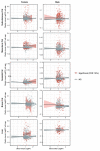Transcriptional memory of dFOXO activation in youth curtails later-life mortality through chromatin remodeling and Xbp1
- PMID: 37118537
- PMCID: PMC7614430
- DOI: 10.1038/s43587-022-00312-x
Transcriptional memory of dFOXO activation in youth curtails later-life mortality through chromatin remodeling and Xbp1
Abstract
A transient, homeostatic transcriptional response can result in transcriptional memory, programming subsequent transcriptional outputs. Transcriptional memory has great but unappreciated potential to alter animal aging as animals encounter a multitude of diverse stimuli throughout their lifespan. Here we show that activating an evolutionarily conserved, longevity-promoting transcription factor, dFOXO, solely in early adulthood of female fruit flies is sufficient to improve their subsequent health and survival in midlife and late life. This youth-restricted dFOXO activation causes persistent changes to chromatin landscape in the fat body and requires chromatin remodelers such as the SWI/SNF and ISWI complexes to program health and longevity. Chromatin remodeling is accompanied by a long-lasting transcriptional program that is distinct from that observed during acute dFOXO activation and includes induction of Xbp1. We show that this later-life induction of Xbp1 is sufficient to curtail later-life mortality. Our study demonstrates that transcriptional memory can profoundly alter how animals age.
© 2022. The Author(s), under exclusive licence to Springer Nature America, Inc.
Conflict of interest statement
The authors declare no competing interests
Figures















References
Publication types
MeSH terms
Substances
Grants and funding
LinkOut - more resources
Full Text Sources
Molecular Biology Databases

